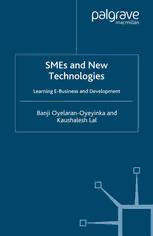Table Of ContentSMEs and New Technologies
Also by Banji Oyelaran-Oyeyinka
LEARNING TO COMPETE IN AFRICAN INDUSTRY
SMEs and New Technologies
Learning E-Business and Development
Banji Oyelaran-Oyeyinka
Kaushalesh Lal
United Nations University-Maastricht Economic and social Research and training
centre on Innovation and Technology (UNU-MERIT)
© Banji Oyelaran-Oyeyinka and Kaushalesh Lal 2006
Softcover reprint of the hardcover 1st edition 2006 978-0-230-00201-2
All rights reserved. No reproduction, copy or transmission of this
publication may be made without written permission.
No paragraph of this publication may be reproduced, copied or transmitted
save with written permission or in accordance with the provisions of the
Copyright, Design and Patents Act 1988, or under the terms of any licence
permitting limited copying issued by the Copyright Licensing Agency, 90
Tottenham Court Road, London W1T 4LP.
Any person who does any unauthorised act in relation to this publication
may be liable to criminal prosecution and civil claims for damages.
The authors have asserted their rights to be identified
as the authors of this work in accordance with the Copyright, Designs and
Patents Act 1988.
First published 2006 by
PALGRAVE MACMILLAN
Houndmills, Basingstoke, Hampshire RG21 6XS and
175 Fifth Avenue, New York, N. Y. 10010
Companies and representatives throughout the world
PALGRAVE MACMILLAN is the global academic imprint of the Palgrave
Macmillan division of St. Martin’s Press, LLC and of Palgrave Macmillan Ltd,
Macmillan®is a registered trademark in the United States, United Kingdom
and other countries. Palgrave is a registered trademark in the European
Union and other countries.
ISBN 978-1-349-28036-0 ISBN 978-0-230-62545-7 (eBook)
DOI 10.1057/9780230625457
This book is printed on paper suitable for recycling and made from fully
managed and sustained forest sources.
A catalogue record for this book is available from the British Library.
A catalogue record for this book is available from the Library of Congress.
10 9 8 7 6 5 4 3 2 1
15 14 13 12 11 10 09 08 07 06
Contents
List of Tables xi
List of Figures xiv
Acknowledgements xv
1 New Technologies and Economic Development 1
1.1 Introduction 1
1.2 Determinants of new technologies adoption 3
1.3 Learning, knowledge and innovation in development 6
1.4 Knowledge, skills and new technologies 8
1.5 The role of infrastructure in adopting new technologies 10
1.6 The internet and the adoption of e-business technologies 15
1.7 Growth, employment and the adoption of e-business 16
1.8 Outline of the chapters 19
2 Methodological Framework for Studying SME Clusters 23
2.1 Methodology 23
2.2 Study sample and sampling 25
2.3 Origin and characteristics of the Indian clusters 25
2.3.1 Sample size 26
2.3.2 Product profile of firms 27
2.4 Origin and characteristics of the Nigerian clusters 30
2.4.1 Study area 30
2.4.2 Study design 31
2.5 Origin and characteristics of the Ugandan clusters 33
2.5.1 Data sources 34
2.5.2 Basic descriptive 34
v
vi Contents
3 Adoption of E-business and Industry-Specific Factors 36
3.1 Indian firms 37
3.2 Ugandan firms 50
3.3 Nigerian firms 61
3.4 Comparative analysis 66
3.5 Summary and conclusion 69
4 Determinants of E-Business Adoption 71
4.1 Introduction 71
4.2 Data and sample survey 71
4.3 Methodology and framework 72
4.4 Hypotheses 75
4.4.1 Education of managing director 75
4.4.2 Skill intensity 75
4.4.3 Value added 76
4.4.4 Size of firm 77
4.4.5 Export intensity 77
4.4.6 Profitability 78
4.4.7 Learning opportunity variables 78
4.4.7.1 Formal training 78
4.4.7.2 Learning by doing 79
4.4.8 Sources of competitiveness 79
4.4.8.1 R&D activities 80
4.4.8.2 Brand name 80
4.4.8.3 Technological collaboration with
foreign firms 80
4.5 Statistical results 81
4.5.1 Indian firms 81
4.5.2 Ugandan firms 86
Contents vii
4.5.3 Nigerian firms 88
4.5.4 Comparative analysis 90
4.6 Summary 91
5 Learning New Technologies by SMEs:Mechanisms
and Trajectories 93
5.1 Introduction 93
5.2 Theoretical framework 95
5.3 Data sources and hypotheses 97
5.4 Statistical results 99
5.5 Summary 109
Appendix A Learning processes and types of
e-business technologies 111
6 Institutional Infrastructure Supporting E-Business Adoption 113
6.1. Introduction 113
6.2 Data Sources and Measurement Issues 114
6.3 Hypotheses and Analytical Framework 115
6.3.1 Hypotheses 115
6.3.1.1 Technological Infrastructure 115
6.3.1.2 Physical Infrastructure 116
6.3.1.3 Human Resources 117
6.3.2 Analytical Framework 117
6.4 Statistical Analysis 119
6.5 Summary 132
Appendix A Economic wealth and other determinants of
the Internet use in SSA (2000) 134
7 Collective Action,Competitiveness and
E-Business Technologies 136
7.1 Introduction 136
7.2 Analytical framework and methodology 137
viii Contents
7.3 Perception of managing directors 140
7.4 Hypotheses 143
7.4.1 Driving forces 143
7.4.1.1 Management control 144
7.4.1.2 Production cost 144
7.4.1.3 Augmentation of size of
operation 145
7.4.1.4 Competitive environment 145
7.4.1.5 Efficiency in production 146
7.4.2 Collective action indicators 146
7.4.2.1 Learning and training opportunities
in clusters 146
7.4.3 Sources of competitiveness 147
7.4.3.1 Size of operation 147
7.4.3.2 Technological collaboration 147
7.4.3.3 Flexibility in product design 148
7.4.3.4 Overhead costs 148
7.4.3.5 Wages 149
7.4.3.6 Innovativeness 149
7.4.3.7 Product quality 150
7.4.3.8 Delivery schedule 150
7.4.3.9 Market network 151
7.5 Statistical Analysis 151
7.6 Summary 157
8 Growth of Employment and the Adoption of E-Business 161
8.1 Introduction 161
8.2 Background of sample firms and their
technological profiles. 162
Contents ix
8.2.1 Case studies 162
8.2.1.1 Technology producers 162
8.2.1.1.1 Wipro 164
8.2.1.1.2 Infosys 165
8.2.1.1.3 Satyam Infoway 165
8.2.1.2 Technology-using firms 166
8.2.1.2.1 Videocon 166
8.2.1.2.2 BPL 167
8.2.1.2.3 Orient Craft 168
8.2.1.2.4 Gokaldas Images 169
8.2.1.2.5 Sonal Garments 170
8.3 Adoption of e-business technologies and their
consequences 171
8.3.1 Producers 171
8.3.2 Consumers 171
8.3.2.1 Performance 171
8.3.2.2 Employment 172
8.4 Summary 172
Appendix A Product and e-business technology profile of firms 174
9 New Technologies and Export Performance of SMEs 175
9.1 Introduction 175
9.2 Analytical framework 176
9.3 Data and methodology 178
9.4 Hypotheses 179
9.4.1 Intensity of e-business technologies 179
9.4.2 Firm size 180
9.4.3 SKILL 182

